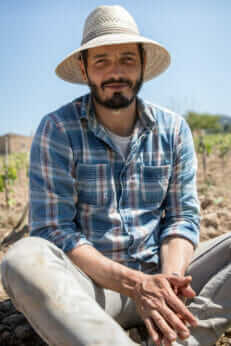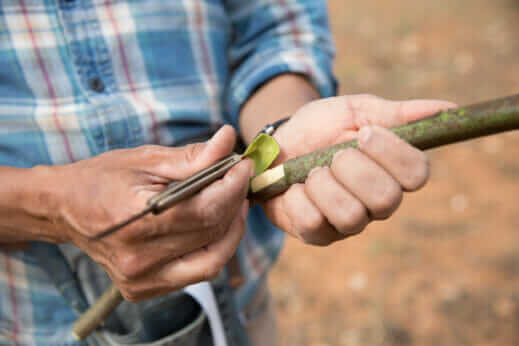Meet the Modern Majorcan Grafter Spreading Biodiversity
One of the youngest men taking on this ancestral practice on the Spanish island, Pere Sureda uses his knowledge of grafting to propagate traditional fruit varieties and preserve local heritage.
Meet the Modern Majorcan Grafter Spreading Biodiversity
One of the youngest men taking on this ancestral practice on the Spanish island, Pere Sureda uses his knowledge of grafting to propagate traditional fruit varieties and preserve local heritage.

Pere Sureda is one of the youngest grafters keeping the tradition alive in Majorca.by Angeles Rodenas
Pere Sureda describes himself as a “spreader of biodiversity.” As a grafter, his technical knowledge and dexterity is helping small producers rescue and preserve traditional local varieties that once dotted the Majorcan countryside, such as Duraió and Bugadera carob trees, Frare Llarg and Frare Verd plum trees and Garta Vermella apricot trees.
Majorca, the biggest of the Balearic Islands, in the Mediterranean Sea, has a long history with trees but also with the art and science of grafting. This horticultural practice is used to join together two separate plants, usually within their own species. Growing as one, they combine the resilience of the one rooted to the soil, called rootstock, with the fruiting qualities of the bud or shoot that is inserted into it.
“In my view, grafting is partly mechanical and partly magical,” says Sureda, as he cuts buds from the twig of a vine in preparation for grafting them. “You take a portion of a plant and add it to another one. [The fruit that grows is] turned into wine that is valued all over the world.”

Applied on the island for more than four hundred years, the technique kept local fruit trees and grapevines alive during the phylloxera plague and, more recently, it is helping to preserve olive and almond varieties that have escaped the Xylella fastidiosa disease. Less than a century ago, there would be several people in each Majorcan village performing the task of grafting, but after the boom in the tourism industry in the 1950s and the stampede to more lucrative jobs in urban areas, land was left unattended and skills were lost. Today, the responsibility of grafting lies with just a handful of professionals. At 39, Sureda is one of the very few people on the island, and possibly the youngest, that has taken on the responsibility of grafting. However, he doesn’t see it as such. “I propagate local varieties,” he says, “but the responsibility of preventing them from disappearing lies with the farm owners,” with whom Sureda works closely.
Sureda studied history and environmental management in Barcelona, returning home to an old family farm in the east of Majorca. There, he researched the recovery of traditional seeds before retraining as a pruner and then as a grafter because he “wanted to work in direct contact with the land,” away from the confines of an office and a desk.
The bulk of his grafting duties are carried out in the spring and autumn at small farms, but during less busy periods, he is able to take requests from locals eager to preserve varieties, such as plum and apricot trees, rooted in the family orchard for generations. If not grafted and multiplied, the trees will eventually naturally die and the variety will quite likely disappear. With the average farm in Majorca clocking in at just 0.72 hectares, small properties form the fabric of the landscape. What happens to small farms shapes the island’s identity. For a countryside that is struggling to survive against a voracious tourism industry, preserving local varieties means keeping local biodiversity and cultural knowledge alive.

Grafting is in particularly high demand in an iconic tree in the Majorcan landscape, native to the Mediterranean area and Middle East: carob. The price of this small fruit peaked last year at 1.55 euros per kilo ($1.37), four times its price in 2018, although it is now sharply falling. Spain is one of the largest global producers of carob and in Majorca neither grafters nor nursery growers were able to meet the demand for the tree at the height of the craze.
Against this backdrop, Sureda has been working with carob plantation owner Xisco Llompart to focus on genetic variability, rather than maximizing the harvest. Llompart’s property is located in the driest area of the island. He has commissioned Sureda to graft half of his plantation in an effort to boost genetic diversity. Current research suggests that trees with broader genetic makeup are more naturally protected against infection, so Llompart and Sureda are using the carob grove as a test plot. However, Sureda says, disease prevention is not that straightforward. “Grafting doesn’t prevent disease. If you take a bud or shoot from a diseased plant, you will also multiply the disease in the graft,” he warns.

Weather permitting, Sureda will start grafting olive trees in April. In May, he helps octogenarian organic winegrower Guillem Sureda and his son Tony to graft the native grape varieties callet, manto negro and fogoneu that, once harvested, will produce young wines. The vineyard is close to his heart, as it is here where Sureda learned to do the chip budding on vines five years ago. It is a backbreaking method performed close to the base of the rootstock, which involves unearthing the rootstock, inserting a bud with a sliver of wood on a matching notch close to the roots, locking the graft with string and covering it again. “If someone ties up the grafts after me, I can do up to 500 a day,” says Sureda. The hard work has paid off; the latest season has had a 99% success rate.
Along with grafting and pruning, Sureda also teaches aspiring growers his craft in order to make a living throughout the year. Following his own mentors, such as Bernat Ramis, one of the most experienced professional grafters on the island, Sureda has amassed a unique knowledge and has adopted a magnanimous approach to it. “I don’t keep anything to myself,” he says. “I try to be as generous with others as people have been with me.”
Follow us

This work is licensed under a Creative Commons Attribution-NoDerivatives 4.0 International License.
Want to republish a Modern Farmer story?
We are happy for Modern Farmer stories to be shared, and encourage you to republish our articles for your audience. When doing so, we ask that you follow these guidelines:
Please credit us and our writers
For the author byline, please use “Author Name, Modern Farmer.” At the top of our stories, if on the web, please include this text and link: “This story was originally published by Modern Farmer.”
Please make sure to include a link back to either our home page or the article URL.
At the bottom of the story, please include the following text:
“Modern Farmer is a nonprofit initiative dedicated to raising awareness and catalyzing action at the intersection of food, agriculture, and society. Read more at <link>Modern Farmer</link>.”
Use our widget
We’d like to be able to track our stories, so we ask that if you republish our content, you do so using our widget (located on the left hand side of the article). The HTML code has a built-in tracker that tells us the data and domain where the story was published, as well as view counts.
Check the image requirements
It’s your responsibility to confirm you're licensed to republish images in our articles. Some images, such as those from commercial providers, don't allow their images to be republished without permission or payment. Copyright terms are generally listed in the image caption and attribution. You are welcome to omit our images or substitute with your own. Charts and interactive graphics follow the same rules.
Don’t change too much. Or, ask us first.
Articles must be republished in their entirety. It’s okay to change references to time (“today” to “yesterday”) or location (“Iowa City, IA” to “here”). But please keep everything else the same.
If you feel strongly that a more material edit needs to be made, get in touch with us at [email protected]. We’re happy to discuss it with the original author, but we must have prior approval for changes before publication.
Special cases
Extracts. You may run the first few lines or paragraphs of the article and then say: “Read the full article at Modern Farmer” with a link back to the original article.
Quotes. You may quote authors provided you include a link back to the article URL.
Translations. These require writer approval. To inquire about translation of a Modern Farmer article, contact us at [email protected]
Signed consent / copyright release forms. These are not required, provided you are following these guidelines.
Print. Articles can be republished in print under these same rules, with the exception that you do not need to include the links.
Tag us
When sharing the story on social media, please tag us using the following: - Twitter (@ModFarm) - Facebook (@ModernFarmerMedia) - Instagram (@modfarm)
Use our content respectfully
Modern Farmer is a nonprofit and as such we share our content for free and in good faith in order to reach new audiences. Respectfully,
No selling ads against our stories. It’s okay to put our stories on pages with ads.
Don’t republish our material wholesale, or automatically; you need to select stories to be republished individually.
You have no rights to sell, license, syndicate, or otherwise represent yourself as the authorized owner of our material to any third parties. This means that you cannot actively publish or submit our work for syndication to third party platforms or apps like Apple News or Google News. We understand that publishers cannot fully control when certain third parties automatically summarize or crawl content from publishers’ own sites.
Keep in touch
We want to hear from you if you love Modern Farmer content, have a collaboration idea, or anything else to share. As a nonprofit outlet, we work in service of our community and are always open to comments, feedback, and ideas. Contact us at [email protected].by Angeles Rodenas, Modern Farmer
March 23, 2023
Modern Farmer Weekly
Solutions Hub
Innovations, ideas and inspiration. Actionable solutions for a resilient food system.
ExploreExplore other topics
Share With Us
We want to hear from Modern Farmer readers who have thoughtful commentary, actionable solutions, or helpful ideas to share.
SubmitNecessary cookies are absolutely essential for the website to function properly. This category only includes cookies that ensures basic functionalities and security features of the website. These cookies do not store any personal information.
Any cookies that may not be particularly necessary for the website to function and are used specifically to collect user personal data via analytics, ads, other embedded contents are termed as non-necessary cookies.
THANK YOU, ANGELES RODENAS and I’m glad to see Modern Farmer getting back into the urgent business of our planet’s survival, away from cutesie “issues.” The carob tree is the future, providing excellent nutrition from the poorest of soils, grafting an essential skill for the furure of all vine + tree crops. GO MOD FARMER. rlgordonjr@hushmail.com
I like to explore biology a lot because it has many interesting things.